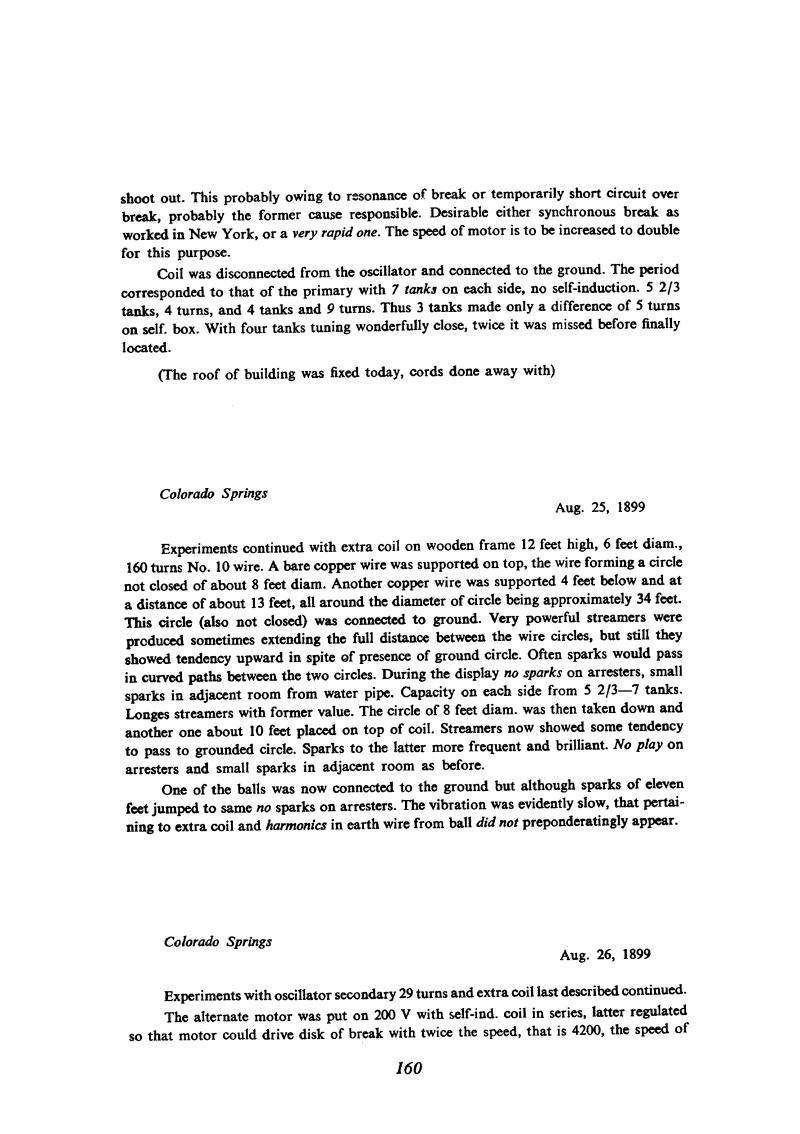
Nikola Tesla Books
shoot out. This probably owing to resonance of break or temporarily short circuit over break, probably the former cause responsible. Desirable either synchronous break as worked in New York, or a very rapid one. The speed of motor is to be increased to double for this purpose.
Coil was disconnected from the oscillator and connected to the ground. The period corresponded to that of the primary with 7 tanks on each side, no self-induction. 5 2/3 tanks, 4 turns, and 4 tanks and 9 turns. Thus 3 tanks made only a difference of 5 turns on self. box. With four tanks tuning wonderfully close, twice it was missed before finally located.
(The roof of building was fixed today, cords done away with)
Colorado Springs
Aug. 25, 1899
Experiments continued with extra coil on wooden frame 12 feet high, 6 feet diam., 160 turns No. 10 wire. A bare copper wire was supported on top, the wire forming a circle not closed of about 8 feet diam. Another copper wire was supported 4 feet below and at a distance of about 13 feet, all around the diameter of circle being approximately 34 feet. This circle (also not closed) was connected to ground. Very powerful streamers were produced sometimes extending the full distance between the wire circles, but still they showed tendency upward in spite of presence of ground circle. Often sparks would pass in curved paths between the two circles. During the display no sparks on arresters, small sparks in adjacent room from water pipe. Capacity on each side from 5 2/3 - 7 tanks. Longes streamers with former value. The circle of 8 feet diam. was then taken down and another one about 10 feet placed on top of coil. Streamers now showed some tendency to pass to grounded circle. Sparks to the latter more frequent and brilliant. No play on arresters and small sparks in adjacent room as before.
One of the balls was now connected to the ground but although sparks of eleven feet jumped to same no sparks on arresters. The vibration was evidently slow, that pertaining to extra coil and harmonics in earth wire from ball did not preponderatingly appear.
Colorado Springs
Aug. 26, 1899
Experiments with oscillator secondary 29 turns and extra coil last described continued.
The alternate motor was put on 200 V with self-ind. coil in series, latter regulated so that motor could drive disk of break with twice the speed, that is 4200, the speed of
160
August 26
Tesla experimented with twice the interruption rate. The oscillator worked better and there was heavy sparking across the lightning arresters (Fig. 4). Investigating the cause of this sparking he inserted a coil in the lead of the metal sphere (Fig. 1) to reject high frequencies. In an earlier experiment (see July 30th) inserting such a choke coil in the ground line had stopped sparking across the arresters. This time it did not, so Tesla tried the circuit in Fig. 2. Still there was no marked change, the sparking across the arresters was only slightly reduced. After this experiment he began to wonder whether the grounding point of the secondary was not perhaps a peak rather than a node of the standing wave. It must be understood that Tesla thought that standing waves were set up around the transmitter (like waves on an open transmission line. With shorter waves the rate of change of amplitude with distance would be faster (i.e. maxima and minima would occur at shorter distance intervals), so he thought that a large potential difference could be obtained with a short distance between the grounding of the secondary and that of the lightning arrester.
In order to explain what happened when the sphere was not grounded (which would mean that there were no short waves) but the sparking across the arrester did not stop, Tesla found it necessary to formulate a new hypothesis: â Could the sparks be produced by static induction upon wire through the air and not chiefly by conduction through earth?â The experiment with which he tried to verify this hypothesis did not yield any definite answer.

